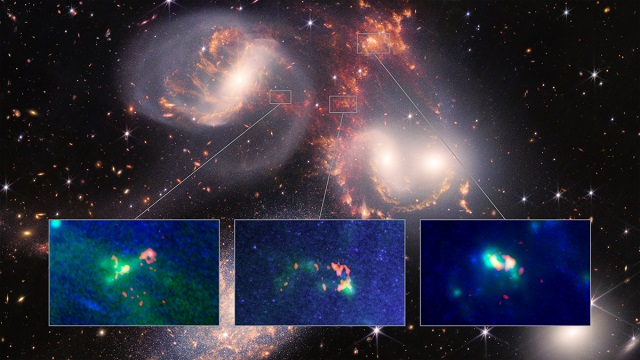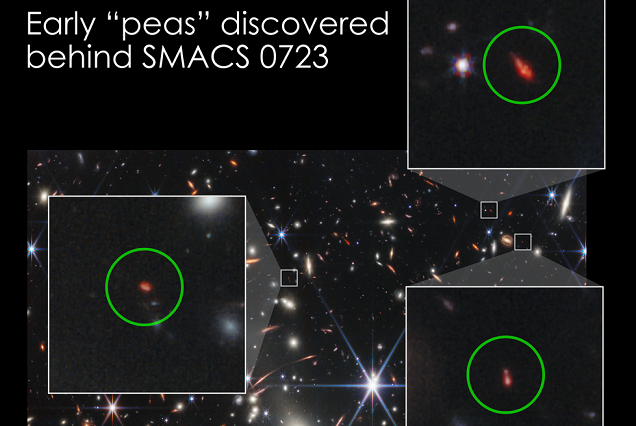
Atacama Large Millimeter submillimeter Array (ALMA) and the James Webb Space Telescope (JWST) discovered a recycling plant for warm and cold molecular hydrogen gas in Stephan’s Quintet
A new analysis of distant galaxies imaged by NASA’s James Webb Space Telescope shows that they are extremely young and share some remarkable similarities to “green peas,” a rare class of small galaxies in our cosmic backyard. NASA observed a group of five galaxies roughly 290 million light-years away. And as if that were not enough, scientists also detected a cataclysmically enormous shockwave caused by an intergalactic collision that left behind a sonic boom – so to speak as there is no sound in the vacuum of space – larger than our own galaxy.
NASA scientists, in cooperation with experts from the Atacama Large Millimeter/submillimeter Array (ALMA) said new observations with the ALMA and the James Webb Space Telescope have revealed that a sonic boom several times the size of the Milky Way has kick started a recycling plant for warm and cold molecular hydrogen gas. What’s more, scientists uncovered the break-up of a giant cloud into a fog of warm gas, the possible collision of two clouds forming a splash of warm gas around them, and the formation of a new galaxy. The observations were presented today in a press conference at the 241st meeting of the American Astronomical Society (AAS) in Seattle, Washington, USA.
The new observations using ALMA’s Band 6 (1.3mm wavelength) receiver— developed by NSF’s National Radio Astronomy Observatory (NRAO)— allowed scientists to zoom into three key regions in extreme detail, and for the first time, build a clear picture of how the hydrogen gas is moving and being shaped on a continuous basis.
Will you offer us a hand? Every gift, regardless of size, fuels our future.
Your critical contribution enables us to maintain our independence from shareholders or wealthy owners, allowing us to keep up reporting without bias. It means we can continue to make Jewish Business News available to everyone.
You can support us for as little as $1 via PayPal at office@jewishbusinessnews.com.
Thank you.
“The power of ALMA is obvious in these observations, providing astronomers new insights and a better understanding of these previously unknown processes,” said Joe Pesce, Program Officer for ALMA at the U.S. National Science Foundation (NSF).
As for the new galaxies discovered by NASA and the James WEBB Telescope, James Rhoads, an astrophysicist at NASA’s Goddard Space Flight Center in Greenbelt, Maryland, who presented the findings at the 241st meeting of the American Astronomical Society in Seattle, said, “With detailed chemical fingerprints of these early galaxies, we see that they include what might be the most primitive galaxy identified so far. At the same time, we can connect these galaxies from the dawn of the universe to similar ones nearby, which we can study in much greater detail.”
Green pea galaxies were discovered and named in 2009 by volunteers taking part in Galaxy Zoo, a project where citizen scientists help classify galaxies in images, starting with those from the Sloan Digital Sky Survey. Peas stood out as small, round, unresolved dots with a distinctly green shade, a consequence of both the colors assigned to different filters in the survey’s composite images and a property of the galaxies themselves.
A round green galaxy seen nearby is compared to a small red dot seen in the infrared by the James Webb Space Telescope. A scale bar shows a distance of 4,000 light-years for both.
A green pea galaxy imaged by the Sloan Digital Sky Survey is shown alongside an infrared picture of an early pea captured by NASA’s James Webb Space Telescope. At left is J122051+491255, a green pea about 170 million light-years away that’s about 4,000 light-years across, a typical size. At right is an early pea known as 04590, whose light has taken 13.1 billion years to reach us. Compensating for the cluster’s gravitational lensing effect and the galaxy’s greater distance to us, 04590 is even more compact, comparable to the smallest nearby green peas.
NASA explains that Green pea galaxy colors are unusual because a sizable fraction of their light comes from brightly glowing gas clouds. The gases emit light at specific wavelengths – unlike stars, which produce a rainbow-like spectrum of continuous color. Peas are also quite compact, typically only about 5,000 light-years across or about 5% the size of our Milky Way galaxy.
“Peas may be small, but their star-formation activity is unusually intense for their size, so they produce bright ultraviolet light,” said Keunho Kim, a postdoctoral researcher at the University of Cincinnati and a member of the analysis team. “Thanks to ultraviolet images of green peas from Hubble and ground-based research on early star-forming galaxies, it’s clear that they both share this property.”




